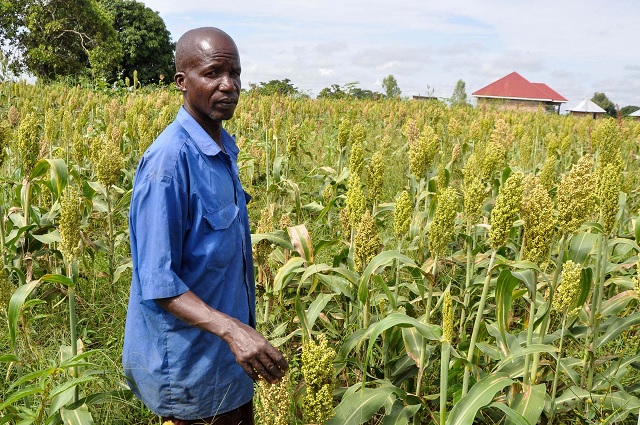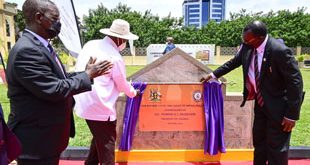
Finger millet and sorghum to be harnessed for genetic resources for increased productivity and utilization
Kampala, Uganda | Isaac Khisa | Finger millet and sorghum are the major crops grown and adapted to the semi-arid region of East Africa providing food, feed and income to the population but they have been placed at the periphery of the countries’ priority crops in the region, experts say.
During the virtual launch of the East African Center of Innovation for Finger Millet and Sorghum in the region to be based at National Semi arid Resources Research Institute (NaSARRI) in Uganda on Thursday (March 09), the experts added that the two crops have the potential to boost food security, improve people’s livelihoods and contribute to industrialization.
But they said countries in the region have not done enough to boost the crop’s production – now at less than a tone per hectare.
“The challenge with these crops has been that they have been subdued to only consumption but also production and productivity is very low,” said Ambrose Agona, Director General at the National Agricultural Research Organisation (NARO), noting that research has been done that shows that finger millet and sorghum can be used in the beer brewing and confectionaries.
So far, NARO has signed a partnership with Uganda Breweries Limited (UBL) with the support of the United States Agency for International Development (USAID) to collaborate in research to transform local varieties specifically sorghum, barley and cassava into high-yielding and aflatoxin-resistant varieties to feed the beer industry for beer production.
The USAID funded project through the Feed the Future Innovation Lab for Crop Improvement at Cornell University, is to be implemented by the National Semi arid Resources Research Institute (NaSARRI) in Uganda in partnership with the Tanzania Agriculture Research Institute (TARI) and the Kenya Agricultural and Livestock Research Organization (KALRO).
Other partners include; Makerere University, International Crops Research Institute for the Semi-Arid Tropics (ICRISAT), Integrated Breeding Platform (IBP) and the National Agricultural Research Laboratories, Kawanda (NARL).
The 3-year project worth US$934,301 is intended to harness finger millet and sorghum genetic resources for increased productivity and utilization in the arid and semi-arid regions of East Africa.
Dr. Scovia Adikini, project leader and principal investigator, plant breeder and geneticist at NaSARRI said the project is expected to benefit more than 400 million people who call dry land regions of sub-Saharan Africa home, though challenges of low productivity, frequent droughts, devastating floods, and pest and disease outbreaks threaten their livelihoods.
She said the East African Center of Innovation for finger millet and sorghum will provide a framework for national breeding programs to leverage resources, strengthen synergies and harness opportunities to accelerate development, release, promotion and adoption of varieties that address the needs of women and men.
“The Centre will bring together the best tools, technologies and methods, and expertise to empower smallholder farmers particularly women, youth and the poor living in semi-arid region of east Africa to transition from a subsistence existence to one of increasing food and nutritional security, incomes, and resilience to shock,” she said.
Kelly Merchan, the communication specialist at Cornell University said the new Centre is one of the four centres that have been established across the world targeting sweet potato, millet, common bean, sorghum and cowpea improvement to boost production.
The other centres are cowpea improvement for yield, disease resistance, adaptation, and nutrition security based in Malawi in partnership with Tanzania and Mozambique; development and dissemination of crop innovations that are key to smallholder farmers and rural populations of West Africa based in Senegal, in partnership with Burkina Faso and Niger; and a regional hub for plant cultivar development and breeding innovation in Central America and the Caribbean based in Costa Rica and Haiti.
Dr. Rebbie Harawa, the regional director and a representative in Kenya at ICRISAT said the current crops’ research needs a new approach that addresses climate resilience, nutritional value and income to farmers.
She said there’s a need for a strong public private partnerships among actors in the agriculture sector to facilitate smooth delivery of technologies and improved crop varieties from research institutions to the farmers to improve crop production.
“Scientists and countries also need to share information, knowledge and capacity building tocomplement on each other’s areas of weakness,” She added.
Dr. Simon Byabagambi, the USAID representative in Uganda reiterated that actors in the agriculture sector need to collaborate to achieve the best results for the farmers in terms of technologies and improved crop varieties to boost the region’s food security.
“Working in silos will not help us,” he said, adding that USAID is implementing various initiatives including improving inclusive market systems, agriculture research activities, commercialization of technologies generated and inclusive community growth to improve food security and incomes to farmers.
 The Independent Uganda: You get the Truth we Pay the Price
The Independent Uganda: You get the Truth we Pay the Price

